Unit 3: Working with Polynomials
Unit 3: Working with Polynomials

Overviews
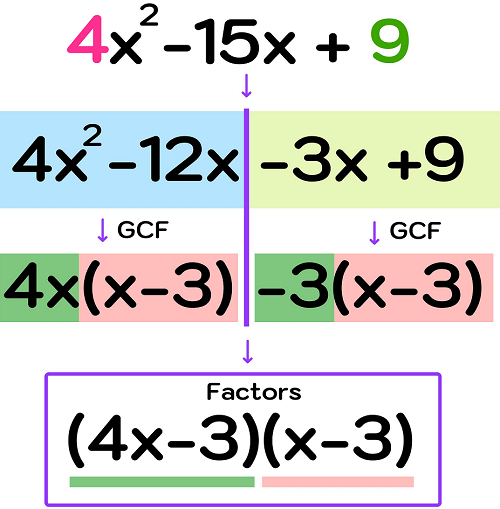
Unit 3: Working with Polynomials
- This unit emphasizes the skills necessary to add, subtract, multiply, and divide rational expressions, simplify them efficiently, and use strategies for polynomial operations.
Unit Focus
Reading Process
Vocabulary Development
- The student will use new vocabulary that is introduced and taught directly.
- The student will listen to, read, and discuss familiar and conceptually challenging text.
- The student will relate new vocabulary to familiar words.
Writing Process
Prewriting
- To develop a personal, organizational style, the student will prewrite using organizational strategies and tools (e.g., technology, spreadsheet, outline, chart, table, graph, Venn diagram, web, story map, plot pyramid).
Algebra Body of Knowledge
Real and Complex Number Systems
- Use the zero product property of real numbers in various contexts to identify solutions to equations.
Linear Equations and Inequalities
- Identify and apply the distributive, associative, and commutative properties of real numbers and the properties of equality.
Polynomials
- Simplify monomials and monomial expressions using the laws of integral exponents.
- Add, subtract, and multiply polynomials.
- Factor polynomial expressions.
- Divide polynomials by monomials and polynomials with various techniques, including synthetic division.
Vocabulary
Continue to the Next Page
Lesson 1: Polynomials

Lesson Overview
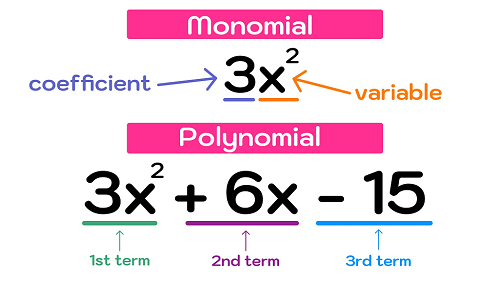
Lesson 1: Polynomials
- We will see that numbers and expressions can be written in various ways by simplifying and performing operations on polynomials. Reformatting a number does not change the value of the number. Simplified expressions often make us see important information that unsimplified versions do not.
Reading Process
Vocabulary Development
- The student will use new vocabulary that is introduced and taught directly.
- The student will listen to, read, and discuss familiar and conceptually challenging text.
- The student will relate new vocabulary to familiar words.
Writing Process
Pre-writing
- To develop a personal, organizational style, the student will pre-write using organizational strategies and tools (e.g., technology, spreadsheet, outline, chart, table, graph, Venn diagram, web, story map, plot pyramid).
Algebra Body of Knowledge
Linear Equations and Inequalities
- Identify and apply the distributive, associative, and commutative properties of real numbers and the properties of equality.
Lesson Reading
Continue to the Next Page
Lesson 2: Addition and Subtraction of Polynomials

Lesson Overview
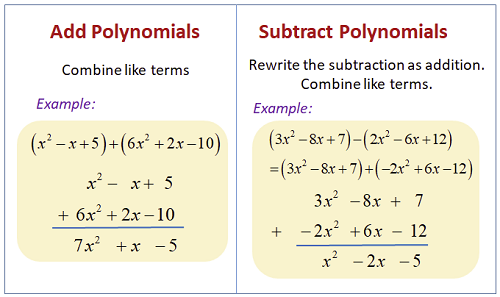
Lesson 2: Addition and Subtraction of Polynomials
Reading Process
Vocabulary Development
- The student will use new vocabulary that is introduced and taught directly.
- The student will listen to, read, and discuss familiar and conceptually challenging text.
- The student will relate new vocabulary to familiar words.
Writing Process
Prewriting
- To develop a personal, organizational style, the student will prewrite using organizational strategies and tools (e.g., technology, spreadsheet, outline, chart, table, graph, Venn diagram, web, story map, plot pyramid).
Algebra Body of Knowledge
Linear Equations and Inequalities
- Identify and apply the distributive, associative, and commutative properties of real numbers and the properties of equality.
Lesson Reading
Continue to the Next Page
Lesson 3: Multiplying Monomials

Lesson Overview
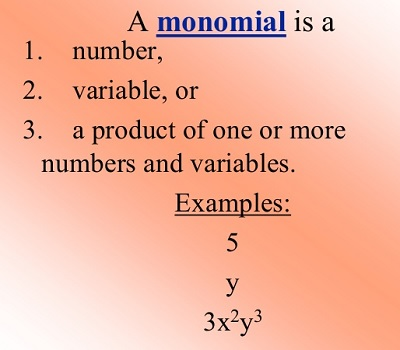
Lesson 3: Multiplying Monomials
Reading Process
Vocabulary Development
- The student will use new vocabulary that is introduced and taught directly.
- The student will listen to, read, and discuss familiar and conceptually challenging text.
- The student will relate new vocabulary to familiar words.
Writing Process
Prewriting
- To develop a personal, organizational style, the student will prewrite using organizational strategies and tools (e.g., technology, spreadsheet, outline, chart, table, graph, Venn diagram, web, story map, plot pyramid).
Algebra Body of Knowledge
Real and Complex Number Systems
- Use the zero product property of real numbers in various contexts to identify solutions to equations.
Linear Equations and Inequalities
- Identify and apply the distributive, associative, and commutative properties of real numbers and the properties of equality.
Polynomials
- Simplify monomials and monomial expressions using the laws of integral exponents.
Lesson Reading
Continue to the Next Page
Lesson 4: Dividing Monomials

Lesson Overview
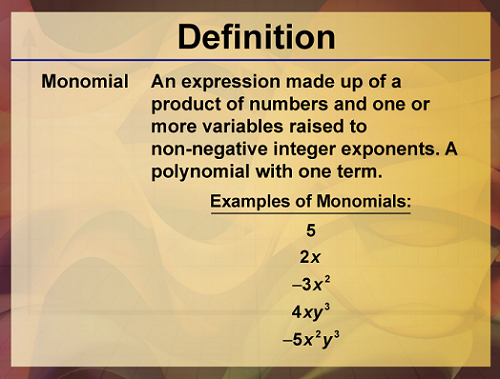
Reading Process
Vocabulary Development
- The student will use new vocabulary that is introduced and taught directly.
- The student will listen to, read, and discuss familiar and conceptually challenging text.
- The student will relate new vocabulary to familiar words.
Writing Process Strand
Prewriting
- To develop a personal, organizational style, the student will prewrite using organizational strategies and tools (e.g., technology, spreadsheet, outline, chart, table, graph, Venn diagram, web, story map, plot pyramid).
Algebra Body of Knowledge
Linear Equations and Inequalities
- Identify and apply the distributive, associative, and commutative properties of real numbers and the properties of equality.
Polynomials
- Simplify monomials and monomial expressions using the laws of integral exponents.
- Divide polynomials by monomials and polynomials with various techniques, including synthetic division.
Lesson Reading
Continue to the Next Page
Lesson 5: Multiplying Polynomials

Lesson Overview
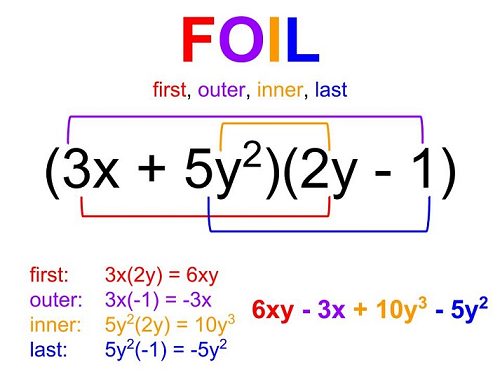
Lesson 5: Multiplying Polynomials
Reading Process
Vocabulary Development
- The student will use new vocabulary that is introduced and taught directly.
- The student will listen to, read, and discuss familiar and conceptually challenging text.
- The student will relate new vocabulary to familiar words.
Algebra Body of Knowledge
Linear Equations and Inequalities
- Identify and apply the distributive, associative, and commutative properties of real numbers and the properties of equality.
Polynomials
- Simplify monomials and monomial expressions using the laws of integral exponents.
- Add, subtract, and multiply polynomials.
- Factor polynomial expressions.
Lesson Reading
Continue to the Next Page
Lesson 6: Factoring Polynomials

Lesson Overview
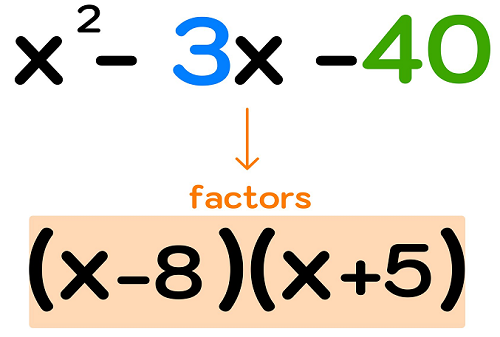
Reading Process
Vocabulary Development
- The student will use new vocabulary that is introduced and taught directly.
- The student will listen to, read, and discuss familiar and conceptually challenging text.
- The student will relate new vocabulary to familiar words.
Writing Process
Prewriting
- To develop a personal, organizational style, the student will prewrite using organizational strategies and tools (e.g., technology, spreadsheet, outline, chart, table, graph, Venn diagram, web, story map, plot pyramid).
Algebra Body of Knowledge
Linear Equations and Inequalities
- Identify and apply the distributive, associative, and commutative properties of real numbers and the properties of equality.
Polynomials
- Simplify monomials and monomial expressions using the laws of integral exponents.
- Add, subtract, and multiply polynomials.
- Factor polynomial expressions.
Lesson Reading
Continue to the Next Page
Lesson 7: Factoring Quadratic Polynomials

Lesson Overview
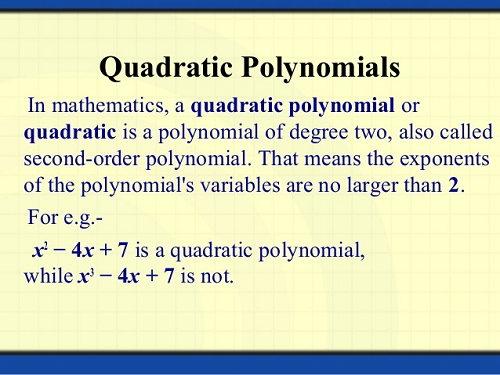
Reading Process
Vocabulary Development
- The student will use new vocabulary that is introduced and taught directly.
- The student will listen to, read, and discuss familiar and conceptually challenging text.
- The student will relate new vocabulary to familiar words.
Writing Process
Prewriting
- To develop a personal, organizational style, the student will prewrite using organizational strategies and tools (e.g., technology, spreadsheet, outline, chart, table, graph, Venn diagram, web, story map, plot pyramid).
Algebra Body of Knowledge
Linear Equations and Inequalities
- Identify and apply the distributive, associative, and commutative properties of real numbers and the properties of equality.
Polynomials
- Simplify monomials and monomial expressions using the laws of integral exponents.
- Add, subtract, and multiply polynomials.
- Factor polynomial expressions.
- Divide polynomials by monomials and polynomials with various techniques, including synthetic division.
Lesson Reading
